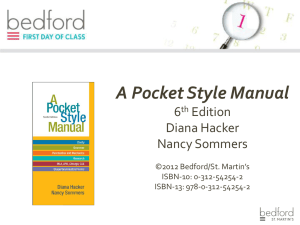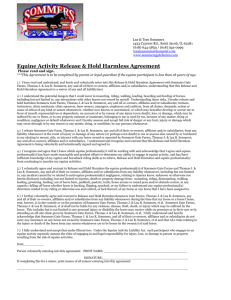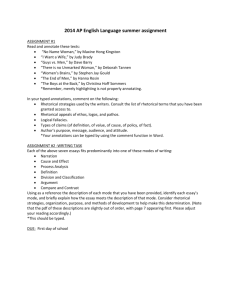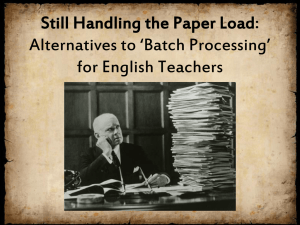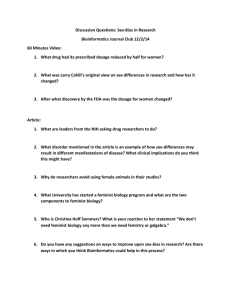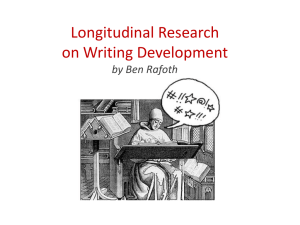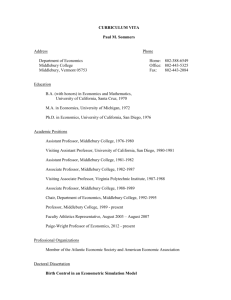Elizabeth Sommers`s essay, “Can Anyody Play: Using the World
advertisement
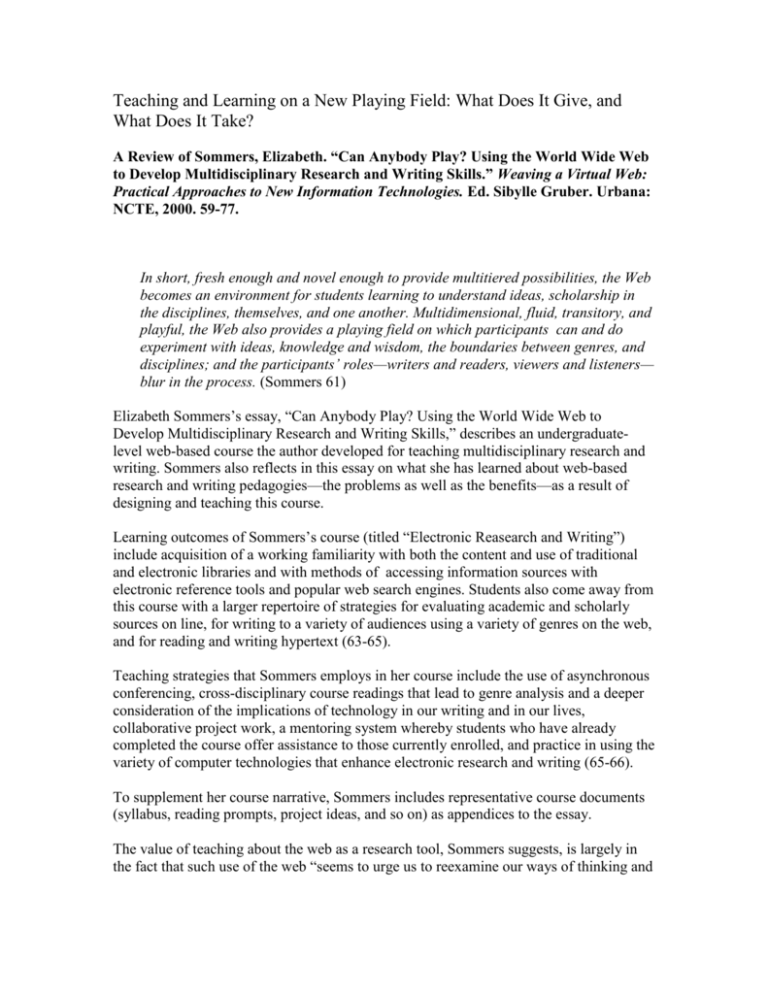
Teaching and Learning on a New Playing Field: What Does It Give, and What Does It Take? A Review of Sommers, Elizabeth. “Can Anybody Play? Using the World Wide Web to Develop Multidisciplinary Research and Writing Skills.” Weaving a Virtual Web: Practical Approaches to New Information Technologies. Ed. Sibylle Gruber. Urbana: NCTE, 2000. 59-77. In short, fresh enough and novel enough to provide multitiered possibilities, the Web becomes an environment for students learning to understand ideas, scholarship in the disciplines, themselves, and one another. Multidimensional, fluid, transitory, and playful, the Web also provides a playing field on which participants can and do experiment with ideas, knowledge and wisdom, the boundaries between genres, and disciplines; and the participants’ roles—writers and readers, viewers and listeners— blur in the process. (Sommers 61) Elizabeth Sommers’s essay, “Can Anybody Play? Using the World Wide Web to Develop Multidisciplinary Research and Writing Skills,” describes an undergraduatelevel web-based course the author developed for teaching multidisciplinary research and writing. Sommers also reflects in this essay on what she has learned about web-based research and writing pedagogies—the problems as well as the benefits—as a result of designing and teaching this course. Learning outcomes of Sommers’s course (titled “Electronic Reasearch and Writing”) include acquisition of a working familiarity with both the content and use of traditional and electronic libraries and with methods of accessing information sources with electronic reference tools and popular web search engines. Students also come away from this course with a larger repertoire of strategies for evaluating academic and scholarly sources on line, for writing to a variety of audiences using a variety of genres on the web, and for reading and writing hypertext (63-65). Teaching strategies that Sommers employs in her course include the use of asynchronous conferencing, cross-disciplinary course readings that lead to genre analysis and a deeper consideration of the implications of technology in our writing and in our lives, collaborative project work, a mentoring system whereby students who have already completed the course offer assistance to those currently enrolled, and practice in using the variety of computer technologies that enhance electronic research and writing (65-66). To supplement her course narrative, Sommers includes representative course documents (syllabus, reading prompts, project ideas, and so on) as appendices to the essay. The value of teaching about the web as a research tool, Sommers suggests, is largely in the fact that such use of the web “seems to urge us to reexamine our ways of thinking and knowing, our ways of sharing and creating ideas” (61). Elaborating on this claim, Sommers observes that in exploring online research practices, Students can and do ask the right questions about the purposes of research, its audience, and the relationship of form to content. Students also can and do ask with is “good” research? Should it provide information, patch together new knowledge, acknowledge wisdom or even strive toward a wisdom of its own? (61) Beyond developing expertise in electronic research and writing, students also benefit from taking this web-based course in the following ways: A web-based pedagogy tends to extend students’ involvement in their own learning (for example, through web-based projects and participation in user groups, email and other web-based communities). Students tend to relate to the course and their learning experience more horizontally—that is, they view the knowledge they are gaining as an enhancement rather than a replacement of their existing knowledge. Web-based discourse provides a contrast to other genres, particularly the academic, and thus prompts greater attention to all discourse forms. The Internet is already a primary medium through which students learn and communicate, and so exploring a new area of web literacy helps students use it more fluently and discerningly. In reflecting her experience in teaching Electronic Research and Writing, Sommers notes some negative aspects, including a frustration that the “staggering” amount of time and effort involved in web-based teaching means she can’t provide much continued support to students beyond the course duration. She also feels challenged by the fact that some students reject the notion of personal agency and authority that web-based pedagogies encourage, for the forms that their resistance takes tend to cause problems for the rest of the class. Sommers offers several pointers to instructors who may be interested in adopting a similar pedagogical approach. First, as a cautionary note, she suggests that the “traditional teacher who prefers to remain the primary authority in the classroom, expects a homogeneous group of students, or fails to provide careful scaffolding for students to learn about both language and technology” (66) would likely find web-based teaching problematic. Sommers advises anyone who is willing to take the plunge into this pedagogical approach to “observe as many classes as you can, talk to as many teachers and students as possible, study lesson plans and the philosophy behind them, and learn to use some of the Web’s capabilities” (67) and to cultivate a technology support system in which you can participate as both learner and mentor and that may involve students as well as colleagues. She also cautions teachers to remember that the dominant form of academic discourse is still linear and print-based, and so any effort to introduce students to the new ways of thinking and knowing that emerge on the “playing field of the Web” (61) needs to be balanced with continued attention to the more traditional kinds of information and knowledge these students may need in their chosen careers. Nonetheless, Sommers celebrates the fact that In various ways, through different means, the participants in Electronic Research and Writing arrive at unique conclusions about the nature of knowledge and information, the limitations of any given way of knowing and the infinite possibilities that open up when many symbol systems, many ways of knowing are embraced. (68-69) As a feminist and teacher who is committed to exploring alternative forms of academic discourse and new strategies for teaching and learning, I read this thoughtful and practical essay with great interest. While Sommers is quick to point out the complexities of webbased teaching, I believe, with her, that at least for some of us, an awareness of the positive aspects of this pedagogical approach for our students will impel us to rise to the many challenges inherent in establishing a new way of teaching. Tracy Ann Robinson WR 520—Computers and Composition Oregon State University 4/30/02
![Marc Sommers public lecture: 31 Jan 2013 [DOCX 385.93KB]](http://s2.studylib.net/store/data/015058057_1-bec2962fc325005f5a48c7cafa75f47b-300x300.png)


